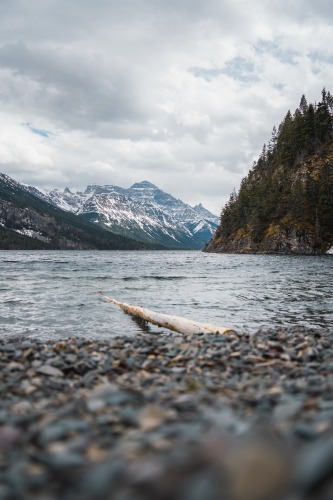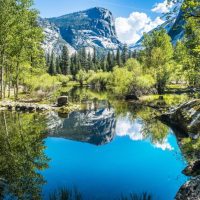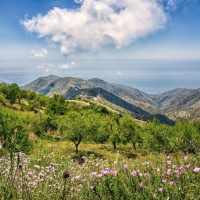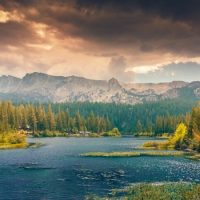Americans love backpacking in Yosemite National Park.
In fact, they love it so much that they have leveled it up to some sort of religious practice.
No wonder why- the place is a rich source of indigenous culture, amazing nature, art, sport, and traces of real evolution and progress.
Here you can experience the mighty Yosemite Falls, admire the El Capitan cliffs and see the wondrous cables of Half Dome.
However, if you visit Yosemite Vally in high season, you will probably bump into big crowds of travelers that are surely not a synonym of relaxing adventure time.

Therefore, backpacking is the real deal.
You can enjoy nature, spend some quality time with yourself away from touristy traps and find a nice spot to rest and hear the sounds of nature.
Check out our tips and tricks for backpacking in Yosemite.
We have covered a wider range of topics, from transportation to the best hikes in the park.

Contents
Best Hikes
Glen Aulin Trail
This trail is 6 miles in total and it starts from Tuolumne trailhead going along Glen Auiln, giving you the chance to experience one of the most appealing scenery in Yosemite.
You will find beautiful alpine lakes, granite, evergreen forests, and views of dramatic mountains.
Not to mention the many waterfalls you will come across your way.
At some point, right under the White Cascade waterfall, you will arrive at the camp called Glen Aulin High Sierra.
The Grand Canyon and the Tuolumne will be close for you to explore as well as the north side of Yosemite where you can go for long excursions.

Cloud’s Rest
This round hike is 14 miles long and perfect for day hiking.
If you get a permit you can spend the night gazing at the amazing Glacier Point and El Capitan.
The beginning of the hike is at Tenaya Lake which is considered one of the most beautiful in Yosemite.
When you reach the peak at the end, you can rest and observe climbers on Half Dome.

Benson Lake Loop
This is the northern part of Yosemite where lie the incredible high alpine mountainous sceneries, with only a small number of tourists and a great chance to enjoy exploring.
The hike around the lake offers a sandy beach and a serene landscape that will make you feel peaceful and relaxed.
You may visit the Smedberg Lake along the route and try out cliff jumping or nude swimming.
It takes 5 days to cross the trail if you start from the Twin Lakes trailhead.
Make sure you reserve two days for the historic Pacific Crest Trail.

Hetch Hetchy to Jack Main Canyon
Hetch Hetchy is not popular amongst hikers but it is definitely worth trying.
It is located on the west side of the park.
At the beginning of the 20th century, before the O’Shaughnessy Dam was created, this place was where John Muir would stop by and spend a few nights with a piece of rudimentary equipment.
You can begin your hike at the trailhead and continue toward Lake Vernon before going to Moraine Ridge and finally descend into Jack main Canyon.
You may find the river going through secluded campsites and see the trail built with ancient rocks.

Big Oak Flat to Yosemite Falls
This route is taking north of the valley, offering mesmerizing views of the best spots of Yosemite.
You can get to the edge of El Capitan and meet some new climber friends and then continue toward the lush-moss forests and river all the way to Yosemite Falls.
Yosemite Falls is located at 2,400 feet and it is one of the mightiest in the world.
The trail along the waterfall will exceed your expectations, we promise!
We only recommend you to mind the slippery ground.

Tips and Tricks
How to Get There?
The closest airports are the Sacramento Airport and the San Francisco Airport.
Also, you take Highway 140 or Highway 120 to enter the park.
The entrance fee is $30.

Permission
Yosemite is among the three most popular national parks in the US.
Therefore, the NPS is quite selective when it comes to giving out permissions.
It’s simple- wherever you decide to camp in the park, you will need permission.
Permissions are free of charge, but you have to register your route that will include your detailed daily itinerary.
For more information on the policies, check out the website of the National Park Service.
Gear
What we really like about backpacking is the freedom and tranquility one feels knowing that their entire life and necessities can fit into a big pouch.
At least for some time.
When people are traveling by car, for instance, they bring more stuff than needed just because they can.
But when you’re backpacking you have to be economic and keep it simple as you will walk a lot and change locations.

Mountain Etiquette (LNT)
What is the famous LNT that all mountaineers and climbers highlight?
It’s quite simple and suggestive- “Leave No Trace”.
This national park policy is the pillar of harmless and enjoyable backpacking and any kind of activity in nature.
The rules are quite common although some require conditioning, like don’t camp on the grass.
Another EXTREMELY important thing to remember about camping in Yosemite is that if you bring smelly stuff with you like chapstick, instant ramen, sunscreen etc, you must seal these in bear canisters.
The bears in Yosemite are Black Bears that you don’t really want to meet but if you do, good luck!
Fire Update: August 2018
In 2018, the Yosemite Valley was evacuated due to the Ferguson Fire in central California.
The park was empty for almost the weeks at the most touristy time in the tear.
However, the situation is almost stabilized and this means that the park will be reopened this Tuesday.
If you plan a visit, have in mind that the quality of the air is in decline and a lot of the wondrous landscapes are now overshadowed by ash.
In addition, it is worth mentioning that the Ferguson Fire is a lesson for paying attention to the fires and pay attention to the fact that public lands and national parks are vulnerable and prone to fires than other types of woodlands.
We must create a constructive plan against prescribed fires in order to defend the national parks.











